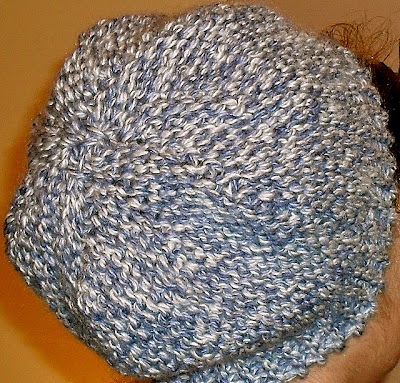When visiting a friend, I observed her cats diving in and out of a polyester / nylon cat tunnel. Our cats can also be found playing in enclosed spaces, especially underneath duvets and blankets. When I saw how much her cats enjoyed playing in the tunnel, I contemplated purchasing one for ours, but on second thoughts I found the material of the so-called cat caves, which are either made from nylon or polyester, somewhat off - putting. Given the choice, I knew that Pickle et al. would prefer hiding and resting in a cozy, knitted object. After all, they choose to fall asleep on my knitting projects. And so the idea for a knitted cat tunnel was born.
 |
| Cat Tunnel in Sirdar Big Softie |
The following is not so much a knitting pattern, rather a description of my project in stages. It is suitable for the beginner knitter, as it only requires knowledge of a few knitting basics:
- You will need to be able to cast on and off.
- You should feel reasonably comfortable knitting on circular needles.
- You need to be familar with the knit stitch.
 |
| Cat Tunnel in progress. |
I used the following materials:
- Bulky yarn of your choice. For my project I used approximately 10 skeins of Sirdar Big Softie. This included the yarn needed to sew in the plastic tubing at either end of the tunnel. As this project is a great exercise in stash busting, you could use yarn leftovers, provided they are of similar thickness.
Knitted Cat Tunnel in Sirdar Big Softie - 10mm circular knitting needles (US size 15).
- 10mm crochet hook (US size N/15) for finishing, sewing in yarn ends and incorporating the plastic tubing. (This can also be done with a large darning needle.)
- Plastic tubing approximately as thick as a standard garden hose (see picture below), available at hardware stores. The length of the tubing is dependent on the circumference at the openings of the tunnel, and I would recommend buying the tubing, once you have completed knitting the tunnel and taken actual measurements of the openings.
- Tape measure, scissors and a Stanley knife (for cutting the plastic tubing).
- Two wooden plugs or sturdy parcel tape to join the plastic tubing
Instructions for a giant slouchy cat tunnel (40cm wide and 70cm long):
Begin by casting on 90 stitches using whichever method you prefer. (I used the cable cast on.) If you want a wider tunnel, cast on more stitches. If you want a smaller tunnel, reduce the amount of cast on stitches accordingly.
Place marker to mark the beginning of the round and join.
Knit mindlessly until the tunnel has the desired length. My tunnel is approximately 70cm long and 40cm wide.
Proceed to bind off all stitches and weave in ends.
After you have finished knitting, you may wish to block the piece in order to stretch and straighten the material. I skipped this part.
Measure the circumference of the tunnel openings at either end to determine the required length of the plastic tubing. The plastic tubing I have chosen has the thickness of a domestic garden hose.
Once you have cut the tubing to size with a Stanley knife, the ends of the tube have to be joined to form a circle. This can be achieved by glueing the ends together with sturdy parcel tape. Alternatively, you can join the ends with the help of a wooden plug, which will ensure a snug fit. (See picture below.) Before fitting the plug, briefly insert the tubes into hot water. This will cause the plastic to expand and the plug can be inserted easily. When the plastic has cooled down, the plug should fit tightly.
Begin by casting on 90 stitches using whichever method you prefer. (I used the cable cast on.) If you want a wider tunnel, cast on more stitches. If you want a smaller tunnel, reduce the amount of cast on stitches accordingly.
Place marker to mark the beginning of the round and join.
Knit mindlessly until the tunnel has the desired length. My tunnel is approximately 70cm long and 40cm wide.
Proceed to bind off all stitches and weave in ends.
After you have finished knitting, you may wish to block the piece in order to stretch and straighten the material. I skipped this part.
Measure the circumference of the tunnel openings at either end to determine the required length of the plastic tubing. The plastic tubing I have chosen has the thickness of a domestic garden hose.
Once you have cut the tubing to size with a Stanley knife, the ends of the tube have to be joined to form a circle. This can be achieved by glueing the ends together with sturdy parcel tape. Alternatively, you can join the ends with the help of a wooden plug, which will ensure a snug fit. (See picture below.) Before fitting the plug, briefly insert the tubes into hot water. This will cause the plastic to expand and the plug can be inserted easily. When the plastic has cooled down, the plug should fit tightly.
When the ends of the tube have been joined, proceed to sew the tube circles into the edges of the knitted tube, using the rolled up edges of the fabric as a guide.
Having followed these steps, your cat tunnel is ready to be enjoyed destroyed (for your cats' safety obviously only under the supervision of a responsible human).
And here are a few impressions of how the tunnel was received by Pickle, Mietze and Pebble:
 |
| Mietze enjoyed it as a seating facility until she was disturbed by Pebble. |




































